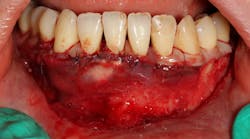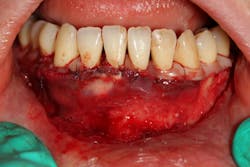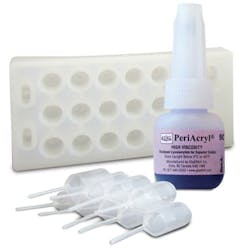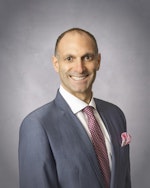Suturing postsurgically is a common technique in the field of dental medicine, particularly after surgical incisions and dental extractions, as the sutures act to secure tissue edges to promote healing. However, suturing can have its disadvantages, too, which is why Dr. Scott Froum uses what is known as "superglue for soft tissue" for dental surgery in his practice.
The technique of suturing postsurgically is commonly practiced in the field of dental medicine. Suturing after a surgical incision or dental extraction acts to secure and approximate the edges of the tissue in order to promote healing. Holding the edges of the tissue flaps in place prevents dehiscence of the wound and promotes healing. Choosing the proper suture material, needle, and filament size is dependent upon the type of surgery performed.
Clinical issues of postsurgical healing
Healing after surgery comes in two forms. If the tissue flaps are in close proximity and the sutures can hold them in that position, healing is in the form of primary intention. (1) This kind of healing contributes to patient comfort, hemostasis, reduction of wound size, and prevention of unnecessary bone resorption.
On the other hand, if surgical wound edges are not properly approximated or the sutures do not hold the tissue together and tearing occurs, hemostasis can be compromised and blood/serum may accumulate under the flap. This could result in a space between the underlying soft tissue and bone, thus delaying the healing process. This type of healing is known as secondary intention and is commonly associated with delayed tissue maturation, irregular tissue contours, scarring, and patient discomfort. (2)
Clinical disadvantages of suturing
Although suturing postsurgically has many benefits, there are some disadvantages. Suture material that is braided can often act like a plaque trap and soak up bacteria. This is known as the "wick effect." (3) Bacteria in close adherence to the wound site can cause infection and delayed healing. In addition, breakdown products from the absorbable suture material itself have been shown to cause an inflammatory reaction in the tissue in certain cases. (4) The length of surgery may also be increased, since suturing—especially in advanced cases—can be time-consuming and technical. Studies have shown that any increase in surgical time can also be correlated with an increase in the postoperative pain a patient may experience. (5)
Alternatives to suturing
Because of these disadvantages, alternatives to conventional suturing have been developed. Some clinicians have recently advocated using innovative surgical techniques as a means of precluding the need for sutures. (6) A cyanoacrylate material developed in the last few decades that has had recent changes in its formulation to make it even stronger is a product known as n-2-butyl cyanoacrylate glue (PeriAcryl from GluStitch). This product has enjoyed longtime use in the plastic surgery and dermatology fields, particularly in the areas of cosmetic- and microsurgery. Although cyanoacrylate has been used for a long time postsurgically, the material itself was expensive, making the costs prohibitive.
Superglue for soft tissue
N-2-butyl cyanoacrylate has changed that cost differential and has similar outcomes when compared with conventional suturing. Known as superglue for soft tissue, n-2-butyl cyanoacrylate is a liquid monomer packaged in a container that polymerizes on contact with aqueous-containing substances, such as blood, and becomes sticky (figure 1).
Figure 1: PeriAcryl used to reinforce sutures
When using it for surface closure in the oral environment, apply the glue in a very thin line along the length of the incision and on both sides for 3 mm to 4 mm. Wait for 10 to 15 seconds; then remove the excess and apply a second coating. Next, coat the material with a petroleum-containing substance (Vaseline) to avoid adherence to the adjacent soft tissue. This material can be used in conjunction with sutures to fortify them in cases with increased tensile forces on the tissue flaps.
The total application process takes less than 20 to 30 seconds, which greatly reduces surgical time compared to traditional suturing. Recent studies have shown that n-2-butyl cyanoacrylate glue demonstrated antibacterial properties in vitro, giving it a possible advantage over suturing as it relates to postoperative infection.
PeriAcryl is available in a preloaded, 0.2 mL single-use applicator and in 1 mL and 5 mL multiuse containers that come with pipettes and autoclavable administration trays (figure 2). The cost per use for these different packaging units ranges from about $1 to $7.
Figure 2: PeriAcryl from GluStitch
References
1. Silverstein LH. Essential principles of dental suturing for the implant surgeon. Dent Implantol Update. 2005;16(1):1-7.
2. Cohen ES. Sutures and suturing. In: Atlas of Cosmetic Reconstructive Periodontal Surgery. 2nd ed. Philadelphia, PA: Lea & Febiger; 1994:9-30.
3. Manor A, Kaffe I. Unusual foreign body reaction to a braided silk suture: a case report. J Periodontol. 1982;53(2):86-88. doi: 10.1902/jop.1982.53.2.86.
4. Lilly GE, Salem JE, Armstrong JH, Cutcher JL. Reaction of oral tissues to suture materials. Oral Surg Oral Med Oral Pathol. 1969;28(3):432-438.
5. Ip HY, Abrishami A, Peng PW, Wong J, Chung F. Predictors of postoperative pain and analgesic consumption: a qualitative systematic review. Anesthesiology. 2009;111(3):657-677. doi: 10.1097/ALN.0b013e3181aae87a.
6. Chao JC. A novel approach to root coverage: the pinhole surgical technique. Int J Periodontics Restorative Dent. 2012;32(5):521-531.











